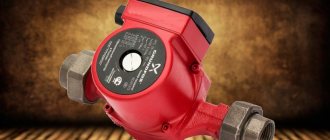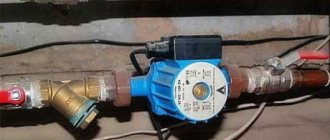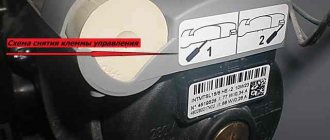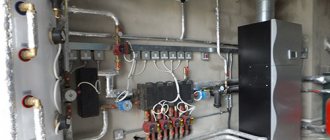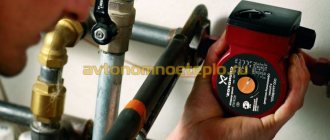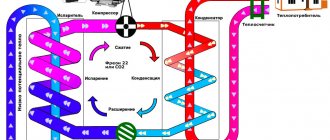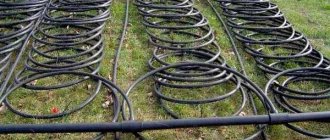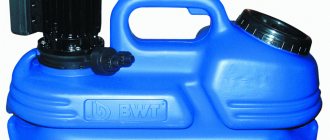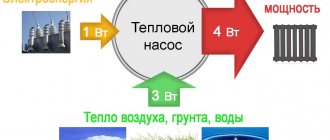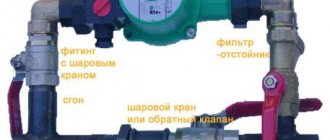General information
Previously, all houses installed a system through which the working environment moved naturally. The movement of water was ensured by heating it in a boiler or even an ordinary furnace. It cooled in the radiators and other elements of the building’s thermal circuit, after which it was returned to the heating equipment. It was according to this simple scheme that it circulated through the pipes.
Nowadays additional equipment is used everywhere. Before installing a pump in a heating system in a private home, specialists perform calculations and select a device, taking into account the characteristics of the building’s thermal circuit. Professionals also take other nuances into account.
On a note! A thermal circuit with natural circulation is just a relatively simple heating circuit. After all, when installing it, pipes must be laid with a slope, batteries are mounted in strictly specified places, and pipelines of exceptionally large diameter are used. In some buildings, all the rules are difficult or impossible to comply with. Therefore, it is not possible to ensure the required coolant circulation through the system.
Conventional diagram of the thermal circuit of a building with natural movement of coolant Source rtkpipe.ru
Professional installation of additional equipment allows you to solve these problems. Most homeowners turn to specialists for help. After all, they know very well how to properly install a circulation pump in a heating system.
The advantage of a system with a pump
Opponents of heating, characterized by forced movement of the medium, note the following disadvantages:
- installing a circulation pump forces you to increase the cost of installing a heating circuit;
- equipment requires an electrical connection, which causes additional costs for electricity;
- the efficient operation of the pumping unit depends on the stability of the power supply, which does not exclude the occurrence of emergency situations if the power supply is interrupted;
- installing an electric pump forces the installation of the entire unit and its regular maintenance, but even in this case it is not protected from breakdowns.
Pumping unit in the heating network of a house Source sovet-ingenera.com
Upon closer examination of each non-delivery, the disadvantages turn out to be not as significant as they seem at first. Moreover, to organize the effective operation of a thermal circuit with gravitational movement of the coolant, one cannot do without certain knowledge, experience, and the implementation of specific rules. Therefore, for its proper installation, you will need the help of specialists who also know perfectly well how to properly install a heating pump in a private home.
To finally find out all the advantages of having a circulation pump unit in the thermal circuit of a building, you need to become more familiar with the system where the coolant moves by gravity.
Schematic diagram of a gravity heating circuit Source oboiman.ru
After determining the installation location of the boiler, be sure to lay a vertical pipeline. It is the accelerating section of the system. For its arrangement, pipes with a large diameter are used. It is recommended to install pipes with a cross-section of at least 1.5 inches.
The acceleration pipeline is laid to the maximum possible height. It should be mounted to a point that is higher than all the radiators in the house. After this, the expansion tank is secured and connected. This device usually has an open design.
The coolant supply pipeline from the expansion tank is laid with a slope of at least 5%. In other words, the slope of the pipe must be at least 50 mm per 1 m. In this case, its cross-sectional size must be at least 1.25 inches.
Descents to radiators are made of pipes with a minimum diameter of 3/4 inch. The return manifold, which is also placed on a slope, is made of rolled pipe with the same cross-section as that of the upper supply pipeline.
Gravity-flow system with an open tank for expansion of the working medium and an accelerating pipe Source tvoya-stroika.ru
Such a heating device with gravity flow forces the boiler to be installed below the radiators. This is not always convenient or possible. In addition, the length of pipelines is increasing. To avoid all the inconveniences, turn to specialists who know very well how to install a circulation pump in the heating system of a private home. After all, it is this that will allow the supply of heated water to the battery at any point in the building.
It is still possible to implement a gravity circuit in small houses where all heated rooms are nearby. However, even with this arrangement of rooms, it is not always possible to install a system with gravitational circulation.
The need to use pipes with a large cross-section makes it necessary to spend more money on organizing heating. Such pipelines are more difficult to install and very difficult to hide in building structures, and sometimes this cannot be done at all. At the same time, professional installation of a pump in a heating system will cost less than the cost of installing a gravity circuit with large pipes and many associated costs.
Pump in the heating circuit of a house Source onlinetrade.ru
Another disadvantage of the gravity system is the inability to conceal the bottom connection of the batteries. This cannot be done even if the project is developed by experienced designers. In a circuit with coolant gravity flow, it will not be possible to create a pressure greater than 0.6 atm. After all, it is formed in the system due to temperature changes and due to different densities of the liquid.
Important! Pressure 0.6 atm. not enough for modern radiators. In addition, you can forever forget about water-heated floors, which are always installed correctly by specialists. However, for them to work effectively, you will need to install a heating pump. If the device is professionally selected, it will always create the required pressure.
An electric pump to create and maintain the required pressure Source leroymerlin.ru
In order for the gravitational circuit to operate at its designed power, it needs a starting impulse. It can only be obtained by increasing energy resources. If even a short shutdown of the boiler unit occurs, then it will take a long time to bring the heating circuit back to normal operation.
In addition, in a gravity circulation system, fluid moves slowly. Its movement is carried out due to the energy of the boiler, and this reduces the efficiency of the unit and the entire intra-house heating circuit. All these problems can be solved by installing a circulation pump for heating - professionals will help you how to install the unit correctly.
Important! Even inexpensive circulation equipment consumes a maximum of 90 W per hour. More expensive models have lower characteristics. It is significantly less than the total energy consumption that will occur when operating heating with gravitational movement of the coolant.
Characteristics, including power, of common circulation units Source 1-teplodom.ru
See also: Catalog of companies that specialize in engineering systems (heating, water supply, sewerage and others) and related work
The low speed of the working medium in the gravitational system is one of the reasons for uneven heating of radiators. In this situation, the heat transfer of the batteries can only be regulated by changing the amount of coolant that passes through them. However, this method will not allow for precise adjustment.
If we take into account that the pressure in the circuit is still low, then there is a high probability of blockage of one of the batteries in the house or even an entire section of the system. In this case, you should completely forget about the possibility of mixing coolant from the return pipeline. Therefore, you shouldn’t even think about high-quality regulation of heat transfer from heating devices.
The conclusion is that the gravitational circuit is not an effective system. Its arrangement leads to irrational consumption of energy resources. Therefore, it is better to spend money once on installing additional equipment than to pay large sums annually for the operation of an inefficient heating circuit. All owners of private residential buildings are recommended to contact professionals who know perfectly well how to install a heating pump in a private house.
Installing a pump in a heating system Source stroikairemont.com
The operation of the circulation pump completely depends on a stable supply of electrical energy. This problem is solved by installing an uninterruptible power supply. It can also simultaneously ensure the operation of the boiler unit. It all depends on its characteristics. Experts will also always help you in choosing a device.
On a note! Even an inexpensive UPS will allow boiler equipment to continue operating when problems arise with the central power supply.
If it is decided to connect a circulation pump, then the homeowner can consider switching the operation of the heating circuit to gravity circulation of the coolant. In most cases, experts offer just such a scheme to owners of modern houses. It involves installing a bypass. A pump and two valves are installed on it. The third shut-off valve is installed in the area that bypasses the bypass.
The advantages of the pump also include its durability if it is manufactured by a reputable company. Homeowners do not have to worry about the vulnerability of such equipment. Typically its service life is tens of years.
Most modern circulation pumps are durable equipment Source elektro56.ru
All pumping units must be serviced regularly to ensure they operate properly for many years. However, the benefits of such a device are undeniable. Therefore, even the purchase of an expensive pump is justified.
Varieties of scheme
The very name of the scheme implies the use of a circulation pump, the purpose of which is to provide pressure and constant movement of heated water. Briefly, the operating principle of the circuit looks like this: water heated to the required temperature is supplied through a pipeline to the radiators. After cooling, it returns to the boiler through the outlet pipeline. The built-in expansion tank provides constant coolant pressure and is designed to withstand the volume of water increasing during heating.
There are several varieties of such a system, divided according to the following characteristics:
- according to the method of connecting the pipeline to the radiators: single-pipe and double-pipe;
- according to the location of the risers: vertical risers and horizontal risers;
- by type of main: dead-end systems and systems with associated water movement;
- by type of wiring: from the top and from the bottom.
Let's figure out how to connect a circulation pump for heating according to each of the indicated schemes.
One-pipe and two-pipe systems
Considered a relic of the past, the single-pipe design involves connecting only one pipe to the radiator. All heating devices in the house are connected in series, and the coolant flows through them, starting from the top and ending with the bottom, giving off more and more heat with every centimeter of progress. Thus, the water reaching the last of the radiators is barely warm, and this creates a strong imbalance in the temperature of different rooms. The only way to somehow reduce this difference is to install radiators with a large number of sections in the lower rooms.
Other disadvantages include:
- the inability to install control valves, since this will automatically shut off or reduce the access of water to the radiators “downstream”;
- unregulated temperature in heated rooms: if the heating system is running, all rooms will be heated.
The single-pipe system was popular half a century ago, but nowadays it is completely outdated and is practically not used.
The two-pipe design eliminates these disadvantages by connecting an inlet and outlet pipe to each battery. In this case, the coolant that loses its temperature is removed from the radiator to the boiler for new heating, and does not move to the next radiator. Another additional advantage: the ability to install on each radiator its own control valve or automatic thermostat.
Vertical and horizontal risers
Connecting radiators to a vertical riser allows pipes to be supplied to them not immediately, but separately for each floor of the high-rise. The main advantage of vertical risers is the absence of air locks. The disadvantage is the relatively high cost.
For slightly different purposes, the installation of a circulation pump in a heating system with a horizontal riser is used: heating staircases, corridors and any large one-story buildings. Its significant advantages are savings on pipes and the resulting low installation costs. A known drawback: the appearance of air jams, which, however, Mayevsky cranes help eliminate.
Dead-end and passing schemes
A widespread dead-end system involves the movement of coolant through the supply pipe in one direction, and through the outlet pipe in the opposite direction. The circulation rings differ significantly in length. Disadvantage of a dead-end system: uneven heating. Those heating devices that are closer to the boiler are more efficient than those that are further away. Even connecting a circulation pump to a dead-end heating system does not guarantee that all radiators will heat equally well. The advantage of such a system: efficiency. Their shortcomings are often smoothed out by installing several small highways instead of one long one.
In a parallel circuit, the length of the circulation rings is always the same. Accordingly, all radiators also heat up equally, being located at any distance from the main riser. Due to the high cost (more pipes are required), the associated scheme is rarely used.
Upper and lower wiring
A heating system with external wiring involves installing a supply pipeline above the radiators.
Typically used in ceiling cavities or attics.
The principle of operation is simple: installing a circulation pump in the heating system allows you to raise heated water to the highest point of the pipeline, from where it will be distributed to the underlying rooms. There, at the highest point, an expansion tank is installed, whose task is to prevent the occurrence of air locks. The outlet pipe, on the contrary, is mounted below the heating device. For obvious reasons, overhead wiring is not applicable in buildings with a flat roof and without attics.
In a scheme with bottom wiring, both (supply and discharge) pipelines are installed below the radiators and at the same time with a slight slope (to prevent the formation of air pockets). The only noticeable advantage of the scheme: the ability to connect heating in stages, floor by floor.
Equipment selection
It's time to figure out how to choose a circulation pump for heating systems, the installation of which has many nuances. The choice of pump is made based on only two parameters: the planned water pressure and the water resistance that the pump will have to overcome to create pressure. Paradoxically, the pump power should be 10-15% less than the calculated values. Otherwise, the amount of electricity consumed, noise and wear rates of parts will be too high. It is foolish to go to the other extreme, saving on pump power. Such a unit will not be able to pump heated water in the required volume at the required speed.
There are models with integrated manual or electronic motor speed controllers. The highest efficiency requires maximum shaft speed. Another non-standard variety is a mini circulation pump for heating, many models of which operate autonomously, without being connected to the electrical network (using diesel fuel or gasoline). Such pumps are excellent for places where electricity is not planned (garden or hunting lodges, construction booths). You can read about another method of heating a room where there is a problem with electricity here.
Main types of pumps for the heating circuit of a private house
Many well-known companies are engaged in the production of circulation pumps. For example, these are Wilo and Grundfos. Regardless of the brand, devices require electricity to operate. In the devices, the hydraulic and electrical parts are isolated from each other. This division is performed in two ways. The design of the pump depends on the specific option.
Dry type pumps
This type of pumping equipment is distinguished by the presence of a so-called dry rotor in its design. In such a device, the hydraulic part is completely separated from the electric drive. In this case, the impeller rotates due to the movement of the shaft around its axis.
Dry-type circulation pumping equipment Source simpalsmedia.com
Pumping equipment with a dry rotor has an elongated housing, since the electric motor is located on the side of the hydraulic unit. Due to this massive shape, a cantilever installation of the circulation pump in the heating system is performed. The installation process is simplified due to the presence of special brackets on the body. The equipment may also have an installation platform.
Pumping electrical appliances with a dry rotor are powerful devices with high performance. They are installed when it is necessary to supply a large amount of coolant. In addition, such pumping devices are capable of creating the necessary pressure to move liquid through extended systems. Therefore, their installation is carried out in large mansions with several floors.
Dry-type pumps have a number of disadvantages:
- Labor-intensive installation due to large dimensions.
- A complex sealing system on a rotating shaft that wears out during operation. Therefore, it is necessary to constantly carry out maintenance, and sometimes even change the sealing elements.
Dry-type pumping equipment with a complex sealing system Source yut-market.ru
- High noise level during operation, as the electric drive is cooled by air. Because of this feature, the installation of a circulation pump in a heating system in a private house is usually carried out in a boiler room, isolated from other rooms of the building.
Wet pumps
Pump circulation devices with a so-called wet rotor differ in design from electrical appliances of the “dry” type. First of all, their pump operating unit is connected to the power element hermetically due to the presence of ring gaskets between them. The two parts are screwed together.
The working unit has the shape of a snail. On both sides there are fastenings that allow connection to heating pipelines. Typically, manufacturers equip equipment with threaded pipes or flanges. The first elements allow coupling connections to be made.
Design of a household circulation pump Source superpumps.ru
The power section contains the stator winding. The pumped liquid never gets into it. To seal this part, the design contains a stainless steel glass. Therefore, the sealing elements are placed on fixed parts. Because of this, they do not wear out when the circulation pump for heating is running - specialists always know how to install it correctly.
An impeller is attached to its rotor shaft. These two parts are rigidly connected to each other. The bearings on which the rotor rests are lubricated with coolant. At the same time, it fills almost the entire space of the device. This allows heat to be effectively removed from the heating parts of the pump. Therefore, it does not overheat and does not need an additional cooling system.
Important! The “wet” type pumping device has an end plug that is used to remove air from the housing. This ensures that the entire device is completely filled with liquid.
At the end of the electric pump there is a plug for bleeding air. Source saucyintruder.org
When the rotor rotates in the working environment, energy losses occur. This reduces the efficiency of pumping equipment. However, this is a minor drawback, since the device consumes a minimal amount of electrical energy.
When operating a “wet” type electric pump, there is practically no noise. The device is easy to install and compact in size. However, you still need to know how to properly install the heating pump. After all, there is one important rule - the rotor axis must always be horizontal. In this case, the device body itself can occupy any position depending on its shape. If the rotor is positioned horizontally, then its bearings will always be wet, which prevents them from breaking due to excess heat.
Important! A filter is installed in front of the pump, which prevents solid particles from entering the bearings of the device.
Features of circulation pumps
In systems with a forced circulation system, a pump is installed to increase heat capacity. Correct installation of the circulation pump in the heating system allows you to change the heat that is transferred depending on the outside temperature while maintaining stability of the heating in the room.
There are two types of such equipment : with a dry and wet rotor. Devices with a dry rotor have increased efficiency (about 80%), do not create much noise and require constant maintenance. The operation of a device with a wet rotor is different; it has a low efficiency (about 50%), is noisier, and its performance is sufficient to heat any private home.
30 years ago, homes used so-called vertical central heating, which was powered by liquid circulating through pipes, and the heat source was a gas boiler or wood-burning stove. Now there has been a transition to the construction of private housing using heaters with a pump, which has the following advantages:
- The coolant speed increases.
- The heat produced by the boiler is quickly delivered to the radiators and returned to its place.
- The heating process is significantly accelerated.
- The speed is higher, so the same amount of heat can be supplied to pipes with a smaller diameter. In other words, a pipe with forced circulation of water in a pump is cheaper. The barrel can now be wrapped with minimal deflection and added complexity. The main thing is to make the correct selection of the pump unit and set the pressure.
- An internal pump for circulating water in the heating system made it possible to have heated floors and efficient closed systems operating under high pressure.
- We managed to remove the pipes that run along the walls and do not always harmonize with the kitchen interior. Nowadays, heating lines are built into the walls, under the floor and behind the suspended ceiling.
As the main disadvantage of the pumps, it can be noted that if there is a need to frequently turn off the circulation pump, a generator must be installed or connected.
Device operation
Despite the large amount of information, many find it difficult to understand where and how to properly install a circulation pump to ensure forced circulation of water in the home heating system. You need to follow the instructions. Often this block is located on the return pipeline , which leads to the following situations:
- The temperature of the liquid in the supply is much higher, so the pump does not work.
- Hot water is less dense.
- The static pressure in the pipeline is higher, which facilitates the operation of the device.
Sometimes, when you get into a room where a boiler is installed that provides heating in the apartment, you can see that the system is based on return. We can say that this is the only correct solution, even if you don’t know about the centrifugal device that can be installed in the outlet pipe.
In an emergency and as a result of an increase in pressure, a safety valve is activated, which releases steam from the boiler. If the action is not completed, the valve allows pressure to be released, resulting in an explosion of the boiler shell.
Experience shows that no more than 5 minutes after the start of the heating process, the safety valve is activated. If you install the device on the return pipeline, steam will not appear in it, and the time before an accident will increase to 20 minutes. That is, if you install a check valve, you cannot prevent an explosion, but you can delay it in order to gain time to make a decision.
Pump operating principle
Circulators operate on electricity. There are two approaches to the system, which leads to their division into “dry” and “wet” type devices. The principle of operation of a dry chain is that the drive is completely isolated from each pump and turbine, and rotation is transmitted through the shaft. As a rule, such devices are quite massive.
Dry pumps for circulating water in a heating system are powerful and efficient devices that provide very high flow rates and high pressure in the system. Without them it is difficult to control the heating. They must be installed in an apartment or private house. However, there are some disadvantages:
- The shaft that transmits rotation is a complex sealing system that prevents leakage of liquid under pressure. These seals gradually wear out, requiring regular preventive maintenance, including replacement with new ones.
- The operation of the pump is always accompanied by an air-cooled sound effect.
Finally, the system is a very expensive choice; the best option would be to purchase a wet rotor pump. The vertical wet rotor pump also comes in different types.
One-pipe and two-pipe systems
Experts distinguish between two heating schemes with forced circulation of the thermal agent - one-pipe and two-pipe. The choice of one or another option determines not only the location of the circuits, but also the length of the pipelines, as well as the type and quantity of equipment for shutdown, regulation and control.
A single-pipe heating system is characterized by the sequential inclusion of heating radiators in the circuit. The coolant returns through a separate pipeline to the boiler only after it turns one by one through all the devices of the system. The disadvantage of this method is that radiators that are closer to the thermal block become warmer than those further away, and this reduces thermal efficiency and equipment life. Introducing a circulation pump into the circuit and equalizing the temperature is achieved at all points of the system.
A two-pipe arrangement has advantages over a single-pipe arrangement, since all heating devices are connected in parallel to the supply and return lines, which promotes uniform temperature distribution throughout all rooms. Forced circulation of the refrigerant leads to increased efficiency of the system and the ability to regulate its thermal power.
Basic selection parameters
Before connecting a circulation pump to the heating system, professionals select a device taking into account the features of the existing heating circuit of the house. During this process, they must pay attention to the following parameters of the device:
- The operating voltage should be 220 V. This characteristic allows you to connect the electric pump to a household power line. Therefore, there is no need to install separate wiring.
- Power – the optimal value is the minimum value. It is recommended to choose a device with power consumption class A. This device is the most economical. As the class decreases, power consumption increases.
Manufacturers produce modern pumping units with two or even three operating modes. They allow you to change the pressure of the pumped liquid. At the same time, the power of the device will change. These parameters are usually marked on the body of the electric pump.
Installation recommendations
The pumping unit is installed in the network in compliance with certain rules and requirements. For the purpose of familiarization, we list all the rules for installing pumps:
- The unit can operate in both vertical and horizontal positions. During installation, the direction of fluid flow indicated by the arrow on the housing must be observed;
- When installing the unit, it is necessary to observe its orientation in space. The pump must be placed so that its rotor is in a horizontal position, and not with its head up or down, as shown in the figure below;
- so that the pump can be removed for maintenance or repair, shut-off valves are installed before and after it;
- the unit is installed on the bypass line, and a tap is placed on the direct line, then if it is turned off, the system will be able to continue operating without forced circulation;
- if a circulation pump is installed in an open heating system, then it is better to place a strainer (dirt filter) on the bypass, in front of the pump, but after the tap. In pressure networks, the mud trap must be installed in front of the bypass, and when piping a solid fuel boiler - in front of the three-way valve.
Advice. It is also not recommended to install the unit horizontally with the terminal box down. If it doesn’t work out otherwise, then you need to unscrew the 4 screws securing the case, turn it 180º together with the box and screw the screws into place.
There is one subtle point. In a scheme where forced circulation of the coolant was originally conceived, installing a bypass often does not make sense. After all, without a pump, water will still not flow through the pipes, since the slopes, diameters, and so on are wrong. Therefore, you can safely build the unit into the return pipeline between the expansion tank and the boiler, as demonstrated by the diagram for installing a circulation pump in the heating system shown in the figure:
The bypass line for the pump should be installed only in systems previously designed as gravity flow. The figure below shows the installation diagram corresponding to this case:
Advice. Sometimes, instead of a ball valve, a reed-type check valve is installed in a straight line of the gravity system. While the pump is operating, it presses the valve petal with its pressure and the straight line is closed. But as soon as the electricity is turned off, the pumping unit stops, the pressure drops and the valve in the straight line opens. Thus, the system switches to natural circulation mode automatically.
Installation of an electric circulation pump
Before starting installation work, each specialist already knows where to install the pump in the heating system - on the supply or return. Typically the installation is carried out on the return pipe. Installation is carried out directly in front of the boiler. In this case, it is better to choose a place after the tank in which the coolant expands.
On a note! It is recommended to install expansion tanks with a membrane in heating systems with quiet movement of the working medium. It is for this reason that the installation of electric pumps is carried out after them. After all, a device for circulating coolant contributes to the creation of flow turbulence.
If an open tank is installed, then the electric pump can be installed anywhere in the common return pipeline, but only after the last connection into it. The same recommendation applies to the membrane expansion tank. The location of the electric pump on the return line after the expansion tank extends the service life of the circulation device. Indeed, in this case it will pump a cooler coolant than when installed on the supply side.
Layout of the pump on the return after the expansion tank Source 1-teplodom.ru
Important! Modern pump models are designed to operate at a maximum temperature of 110°. This allows them to be installed on the supply pipeline. However, when choosing this option, you need to carefully balance all the parameters of the thermal circuit. After all, after the pumping unit, the working environment receives a vacuum. Taking this point into account, circulation devices should not be installed immediately behind the boiler, since when the heating circuit operates at maximum, boiling of the liquid in the batteries may occur. This situation poses a great danger.
Advice! If the pump is installed on a supply pipeline, then it must be installed at the greatest possible distance from the boiler unit.
Before connecting a circulation pump, professionals always first study the existing system. If branches extend from the central supply pipeline in different directions, pumping devices are installed on each of them. Such heating circuits are often found in buildings with extensions or in large houses that have two wings.
One of the options for a branched heating circuit with two circulation pumps for radiators and heated floors Source akak7.ru
In buildings with a branched thermal circuit, the optimal place to install the electric pump is the supply pipeline, but only after it has branched. In this case, the circulation device must be installed before the battery or the first riser.
When choosing a location for a circulation device, they are guided by the heating scheme in a particular house. There is no general rule for the placement of a device that pumps coolant. Specialists take into account the characteristics of a particular heating network and the availability of free space on its pipelines.
In addition, professionals control the location of the device’s rotor axis relative to the ground. It must always be parallel to the horizon. In addition, access to the electrical pump installation box is provided. After all, it is designed for connecting wires and there is a mode switch in it. Therefore, the installation box should not be located at the bottom of the device.
Where should the pump be installed?
The role of the pumping device in heating systems is clear to everyone. But questions often arise about the place of its installation. There are only two options here:
- on the supply pipeline after the boiler and safety group;
- on the return line directly in front of the boiler.
The number of supporters of installation in the return pipeline is large, but few of them can argue their position, just like those who like to install the unit in the supply. So, in practice, the installation location plays absolutely no role and does not have any effect on the operation and thermal power of the system. Also erroneous are the statements that, due to the lower return temperature, the pump will last longer, that it is easier to pull than to push, and other statements in the same spirit.
In private homes, the temperature in the supply line rarely reaches 70 ºС, not to mention the estimated 90 ºС. The exception is the cold northern regions, but there the approach to heating buildings is somewhat more serious. The circulation units themselves are designed for high water temperatures and they jam for other reasons, for example, due to the low quality of the coolant containing various impurities. From a hydraulic point of view, the circulation pump can be installed on any of the two branches; the system parameters will not change.
Then why is the unit most often placed on the return line? Everything is quite simple. In the event of some malfunction and overheating of the boiler, the water in its tank will begin to boil, and the steam-water mixture will move into the system. But the pump can only pump an incompressible medium, that is, liquid. When steam gets into it, the pumping process will stop, the coolant in the network will stop, and the boiler will explode if measures are not taken.
Important. Most modern heat generators are well protected from overheating, there is nothing to worry about. In this regard, only solid fuel boilers pose a danger, so near them it is necessary to install a return pump only.
Features and installation procedure of the electric pump
To find out how to properly install a circulation pump, it is recommended to use the heating project. It is usually developed during the design stage of the house. If the heating circuit of a building is being modernized, then in this situation the best place to install the device is the bypass.
The presence of a jumper with an electric pump, filter and shut-off valves allows the heating network to function if the building loses power or an electrical appliance breaks down. Thanks to the bypass, it will be possible to switch the system to circulate the medium naturally. This will prevent you from being left completely without heat in the event of an emergency.
The bypass jumper can have almost any configuration. Often there is not enough space for installation. Therefore, non-standard solutions are being implemented. However, more often the installation is still carried out according to standard schemes.
One of the options for a bypass jumper for an electric heating pump Source e.allegroimg.com
If there is free space, a ready-made bypass assembly is usually installed. This design is manufactured in production shops. It is equipped with taps or valves are built into it. The finished bypass unit can be mounted by welding or connected via thread. Any such structure has a free area intended for installing an electric pump using flanges or couplings.
Thermal circuits in houses are often created from polypropylene pipes. This option simplifies the process of installing a circulation device for pumping coolant. The master usually spends about 1 hour on the work. More time is required if installation is carried out on metal pipes. It is necessary to use not only welding, but also packing of threaded connections.
During installation of the circulation pump, the technician carries out the following actions:
- prepares components - filter, shut-off valves, threaded pipes, drains;
- connects all threaded elements of the assembly using a special sealing tow and paste;
- assembles the loop together with the pump without carefully tightening the union nuts;
An assembled loop with a pump and a unit that is mounted underneath it Source 1-teplodom.ru
- outlines and cuts out an area on the return line for installing the tap;
- carries out welding work - first tacks the metal elements of the assembly, then removes the pump to prevent it from being damaged by welding splashes and completes the operations started;
- assembles the unit under the pump and carries out its installation;
- the circulation device is installed in place;
- carries out the final tightening of the American electrical appliance.
Important! On the electric pump, the direction of the arrow must coincide with the actual movement of the working medium in the heating pipeline.
At the end of the work, the master connects the wires. They are connected to the terminals located in the mounting box of the circulation device.
Connection options
An open-type heating system with a pump can be implemented using one of the proposed methods. Each of them has its own strengths and weaknesses, but you should make your own decision about which of the proposed options is right for you. For example, for a garage the first scheme will be appropriate, while for a building with several floors a different implementation will be needed.
The design of a heating system with a pump is quite simple and can be implemented on its own, without the involvement of third-party specialists.
Hybrid
This option assumes that in the event of a power outage, the circuit will continue to operate according to the emergency option, and even with minor losses, it will still continue to supply heat where it is needed.
It is implemented using a horizontal pipe laying method. The pipes must be larger in diameter than with other connection options. The coolant, heating up in the boiler, rises through the pipes thanks to the laws of physics, and flows through a horizontal pipe located under the ceiling with a slight slope. From the main pipe there are bends down to the radiators. Moving according to the proposed scheme, the water cools and flows down, going into the lower horizontal route, along which it returns to the boiler for reheating.
The disadvantages of such a connection are the need to lay an upper route from large-diameter pipes, which attracts attention, low circulation speed and uneven heat distribution. In addition, such an option must be carefully calculated, using pipes of different diameters in different areas to compensate for heat distribution. But there is only one advantage: the system is autonomous and, in combination with a solid fuel boiler, practically requires nothing but fuel.
When there is electricity, water is pumped through the pipes, the speed of the current increases, heating occurs faster and spreads more evenly.
Single-pipe
The option is practically no different from the one described above, except that the pipes can be taken of a smaller diameter, and the riser can be run along the floor. This connection option is known as Leningradka, in honor of the city where it was developed and first implemented.
Leningradka is an excellent way to install heat in a house; it is implemented as follows: Water, heated in the boiler and pumped through a pump, moves along a horizontal riser. From which branches go upwards to the heating radiators. The riser itself can be hidden in the floor. Installing needle valves at the inlet and outlet of the radiator allows further maintenance without shutting down the entire network. Installing such a valve in the area located between the outlets to the heating radiator allows for further fine tuning and equalization of heating in different sections of the circuit.
Two-pipe
As the name suggests, it involves the use of two risers. One of them supplies heat to the radiators, the second one removes it from them. It is used mainly for the purpose of being able to adjust the temperature of each individual radiator in each individual room. The radiators are supplemented with rheostats, and due to the fact that the coolant is supplied to each of them almost simultaneously and has the same starting temperature, they can be adjusted with extreme precision.
In addition, this connection allows you to supplement the system by installing warm floors, taps in the hot water supply line and other necessary additions.
Briefly about the main thing
Installing an electric pump in the heating circuit of the house allows you to provide the necessary pressure in it. This will allow the premises to be heated as efficiently as possible. Electric pumps are installed in homes in “dry” and “wet” versions. The second type of device is more common.
They usually try to install the electric pump on the return line after all radiators, tie-ins and a reservoir for expansion of the coolant. If necessary, it can be mounted on the supply, but at the maximum distance from the boiler.
The pump is installed on a bypass. This is a loop with a filter and shut-off valves. First, all its elements are assembled into a single structure, and then it crashes into the main pipeline with a separate tap to shut it off.
Ratings 0
